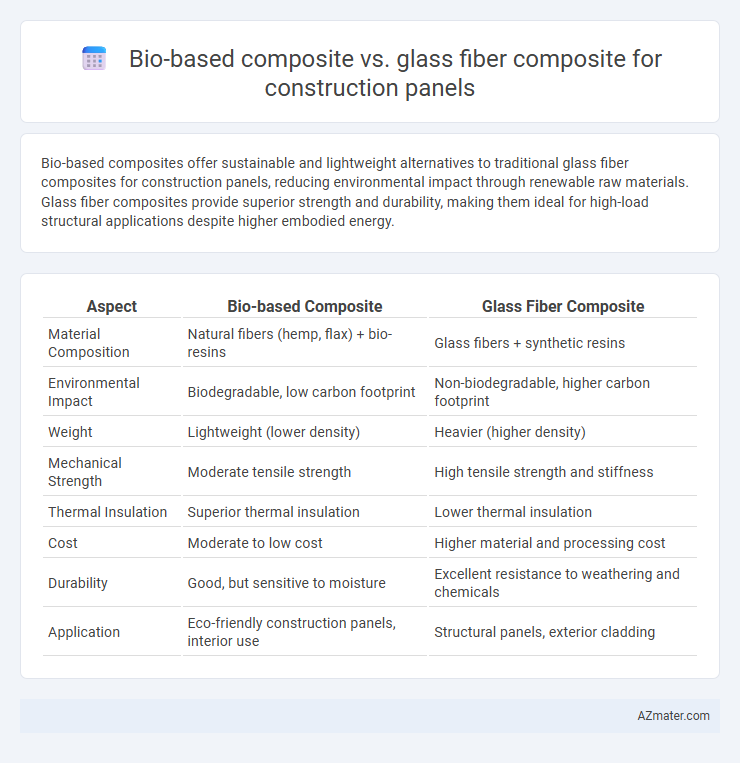Bio-based composites offer sustainable and lightweight alternatives to traditional glass fiber composites for construction panels, reducing environmental impact through renewable raw materials. Glass fiber composites provide superior strength and durability, making them ideal for high-load structural applications despite higher embodied energy.
Table of Comparison
| Aspect | Bio-based Composite | Glass Fiber Composite |
|---|---|---|
| Material Composition | Natural fibers (hemp, flax) + bio-resins | Glass fibers + synthetic resins |
| Environmental Impact | Biodegradable, low carbon footprint | Non-biodegradable, higher carbon footprint |
| Weight | Lightweight (lower density) | Heavier (higher density) |
| Mechanical Strength | Moderate tensile strength | High tensile strength and stiffness |
| Thermal Insulation | Superior thermal insulation | Lower thermal insulation |
| Cost | Moderate to low cost | Higher material and processing cost |
| Durability | Good, but sensitive to moisture | Excellent resistance to weathering and chemicals |
| Application | Eco-friendly construction panels, interior use | Structural panels, exterior cladding |
Introduction to Construction Panel Materials
Bio-based composites for construction panels combine natural fibers like hemp, flax, or jute with bio-resins, offering enhanced sustainability, reduced carbon footprint, and improved biodegradability compared to traditional materials. Glass fiber composites consist of glass fibers embedded in a polymer matrix, providing high strength, durability, and resistance to moisture and fire, making them a standard choice for structural applications. The choice between bio-based and glass fiber composites depends on balancing environmental impact, mechanical performance, and cost-effectiveness in construction panel manufacturing.
Overview of Bio-based Composites
Bio-based composites for construction panels utilize renewable natural fibers such as hemp, flax, or jute combined with biodegradable or bio-based resins, offering enhanced sustainability and reduced environmental impact compared to traditional glass fiber composites. These composites provide comparable mechanical strength and thermal insulation while significantly lowering carbon footprint and improving recyclability. Their biodegradability and lower toxicity make bio-based composites an eco-friendly alternative in green building applications.
Overview of Glass Fiber Composites
Glass fiber composites consist of a polymer matrix reinforced with fine glass fibers, offering high strength-to-weight ratio and excellent durability for construction panels. These composites provide superior resistance to impact, moisture, and temperature variations, making them ideal for structural applications in harsh environments. Manufacturing processes allow for flexibility in design, enabling customized panel thickness and shape while maintaining cost-effectiveness and scalability in production.
Mechanical Properties Comparison
Bio-based composites in construction panels exhibit superior environmental benefits but generally have lower tensile strength and stiffness compared to glass fiber composites, which offer higher durability and load-bearing capacity. Glass fiber composites typically demonstrate enhanced impact resistance and fatigue performance, making them suitable for heavy-duty structural applications. However, advancements in bio-based fiber treatments and matrix improvements are gradually narrowing the mechanical performance gap, promoting sustainable alternatives in the construction industry.
Environmental Impact and Sustainability
Bio-based composites for construction panels significantly reduce carbon footprint due to their renewable raw materials, lower energy consumption during production, and enhanced biodegradability compared to traditional glass fiber composites. Glass fiber composites, while offering high strength and durability, rely heavily on non-renewable resources and generate higher embodied energy, resulting in greater environmental impact over their lifecycle. Sustainable construction increasingly favors bio-based composites for their potential to minimize landfill waste, support circular economy principles, and improve indoor air quality by reducing harmful emissions.
Durability and Weather Resistance
Bio-based composites exhibit enhanced durability due to their natural fiber reinforcement, offering resistance against moisture absorption and biological degradation, which prolongs their lifespan in construction panels. Glass fiber composites provide superior weather resistance with strong mechanical properties and high resistance to UV radiation, chemical attack, and thermal cycling, making them highly durable in harsh environmental conditions. Choosing between bio-based and glass fiber composites depends on balancing sustainability goals with specific durability and weather resistance requirements in construction applications.
Cost Analysis and Market Trends
Bio-based composites for construction panels offer competitive cost advantages due to lower raw material expenses and reduced environmental compliance costs compared to glass fiber composites, which tend to have higher production and recycling costs. Market trends indicate a growing demand for sustainable materials, with bio-based composites experiencing significant growth driven by increasing regulations on carbon emissions and consumer preference for eco-friendly building solutions. Despite the current dominance of glass fiber composites due to their mechanical strength and widespread availability, bio-based composites are rapidly gaining market share thanks to advances in material performance and cost-efficiency.
Manufacturing Processes
Bio-based composite panels utilize natural fibers like flax, hemp, or jute combined with bio-resins through processes such as compression molding or vacuum-assisted resin transfer molding, emphasizing lower energy consumption and reduced environmental impact. Glass fiber composites rely on fiberglass reinforcement embedded in thermoset or thermoplastic resins, often manufactured using hand lay-up, spray-up, or pultrusion techniques that require higher temperatures and energy inputs. The bio-based manufacturing processes typically promote biodegradability and sustainability, whereas glass fiber composite production prioritizes mechanical strength and durability through more energy-intensive methods.
Applications in Modern Construction
Bio-based composites offer sustainable alternatives to glass fiber composites in modern construction panels, providing enhanced environmental benefits such as reduced carbon footprint and improved recyclability. Glass fiber composites maintain superiority in high-load structural applications due to their exceptional strength, durability, and fire resistance, making them suitable for demanding building components. Increasingly, hybrid panels combining bio-based fibers with glass fibers optimize performance while promoting eco-friendly construction practices in walls, facades, and insulation systems.
Future Prospects and Innovations
Bio-based composites for construction panels exhibit promising future prospects due to their sustainability, biodegradability, and reduced carbon footprint compared to traditional glass fiber composites. Innovations in natural fiber treatments and resin formulations are enhancing mechanical properties and durability, making bio-based composites increasingly competitive for structural applications. Emerging trends include hybrid composites combining bio-based fibers with glass fibers to optimize performance and environmental impact in next-generation construction materials.

Infographic: Bio-based composite vs Glass fiber composite for Construction panel
 azmater.com
azmater.com